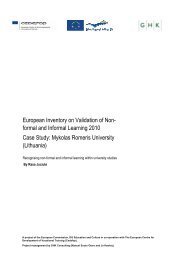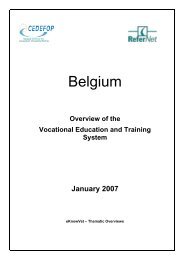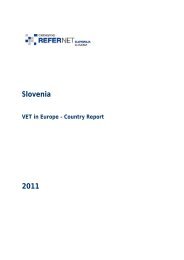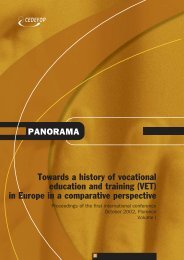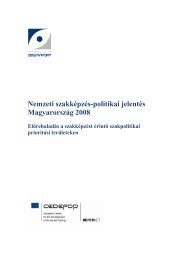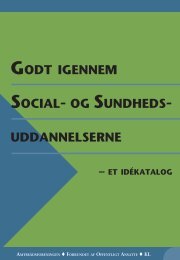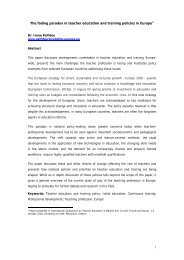PROFF – Professionalisation of VET teachers for the future - Europa
PROFF – Professionalisation of VET teachers for the future - Europa
PROFF – Professionalisation of VET teachers for the future - Europa
Create successful ePaper yourself
Turn your PDF publications into a flip-book with our unique Google optimized e-Paper software.
DefinitionsIn-service trainingDifferent European countries use different terms to describe training taking place after initialtraining. In this study, we use <strong>the</strong> term in-service training. Following <strong>the</strong> definition proposedby <strong>the</strong> Eurydice network in-service training denotes all activities and practices intended tobroaden <strong>teachers</strong>’ knowledge, improve <strong>the</strong>ir skills and to help <strong>the</strong>m assess and develop <strong>the</strong>irpr<strong>of</strong>essional approach (Eurydice, 1995). By this definition, in-service training includes abroad range <strong>of</strong> programmes and courses set up by employers or by local, regional or nationalauthorities.<strong>Pr<strong>of</strong>essionalisation</strong>The concept <strong>of</strong> pr<strong>of</strong>essionalisation is ambiguous. It can be understood as a strategy to protecta pr<strong>of</strong>ession from outside competition, by defining <strong>the</strong> skills and competences required toenter <strong>the</strong> pr<strong>of</strong>ession (as occurs with doctors and lawyers). Obviously this is not <strong>the</strong> definitionused in <strong>PROFF</strong>. In this project, pr<strong>of</strong>essionalisation is closely linked to ef<strong>for</strong>ts to update,upgrade and develop <strong>VET</strong> <strong>teachers</strong>’ competences so <strong>the</strong>y can meet <strong>the</strong> challenges facing <strong>the</strong>irpr<strong>of</strong>ession and act pr<strong>of</strong>essionally in <strong>the</strong>ir daily work. Pr<strong>of</strong>essionalising <strong>VET</strong> <strong>teachers</strong>represents a significant contribution to <strong>the</strong> quality and effectiveness <strong>of</strong> <strong>VET</strong> systems. Itpromotes mastery <strong>of</strong> technical and scientific advances, and enables <strong>teachers</strong> to anticipate anddeal with change.Teacher, trainer, tutor, etc.The concepts <strong>of</strong> teacher, trainer, tutor, etc. are just as ambiguous as pr<strong>of</strong>essionalisation. In<strong>the</strong> data collection <strong>of</strong> <strong>PROFF</strong> this ambiguity resulted in cases with varying target groups,ranging from <strong>teachers</strong> (in <strong>the</strong> strict sense <strong>of</strong> <strong>the</strong> word) to middle managers. Most participantscan none <strong>the</strong> less be considered pr<strong>of</strong>essional educators. Pr<strong>of</strong>essional educators can includetrainers, group leaders, tutors, <strong>teachers</strong>, instructors, trainers <strong>of</strong> trainers, etc. (de Blignières-Légeraud, 2000a).In EU countries <strong>the</strong> term teacher is generally used to name personnel in primary schools,secondary schools and initial vocational training colleges.Tutors are defined as salaried employees <strong>of</strong> <strong>the</strong> enterprise appointed by <strong>the</strong> employer to beresponsible <strong>for</strong> a trainee in initial training, continuing training or retraining within <strong>the</strong>enterprise. A tutor’s main task is teaching trainees (de Blignières-Légeraud, 2000b). Manycountries use <strong>the</strong> term (workplace) instructor.A trainer is a pr<strong>of</strong>essional involved in apprenticeship systems, on-<strong>the</strong>-job and <strong>of</strong>f-<strong>the</strong>-jobtraining activities and, more generally, in private sector training.9



